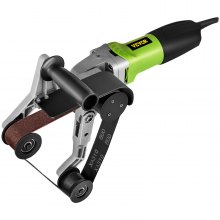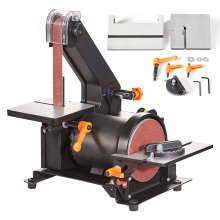
























Sanding is an important step in many wood and metal projects. Whether preparing surfaces anew or smoothing the rough edges of your new furniture, you may need some sanding to complete the project.
You must use the appropriate sanding tool for the right result. Choosing the right tool is a daunting challenge for many so this article will walk you through the process.
Learning about sanding to complete an aspect of the project might seem an overkill, but it is worth the effort. VEVOR, a high-authority machine company, gets you through efficient sanding processes.
A sanding tool is an equipment used to remove the rough parts and scratches from a surface in preparation for furnishing. The purpose of a sanding tool is to make the surface smooth for further finishing touches, such as painting or plastering. Sander grinders come in different forms, from handheld manual sanders to power-operated ones.
A sanding tool works by using the abrasive part of the tool to wear away the material on the surface. It could be anything from wood to metal. Typically, a metal sanding tool is different from the ones used on wood and other materials. The grit of the sander determines its coarseness. The lower grits are rough and used for heavy removal, while higher grits are for polishing, making them typically finer.
With different types of sander grinders, choosing the right one for your project requires knowing what to look for. The first thing is to determine whether you want a manual sander or a power grinding sander. With the manual sander, you rub the sandpaper block or sponge on the surface you want to smoothen. To get the best result, you must apply pressure continuously and follow the wood grain to get your desired result. The types of manual sanders include sanding blocks, sandpaper sponges, and detail sanders.
Power grinders, on the other hand, include belt, orbital, partial orbital, sheet, and detail sanders. Using a power grinder is easier as the motor drives the sanding pad, which is already fitted with sandpaper, over the surface in a specific motion to get the materials off. The tool only needs minimal effort in guiding it across the surface to get the best result.
Now, with the array of options, some factors should guide decisions.
Your choice for woodwork might differ from if you are working with metal. The surface roughness may also determine the grit you opt for. Therefore, ensure the material in question first and proceed from there.
If you desire a very smooth finish, you must prioritize a sanding tool with finer grits and gentle sanding motions. If, on the other hand, you want to remove your rough particles, you should opt for a sander with coarse grit.
Working on a small project does not require a power sander, as a manual sander can easily do the job. If the surface you are working on is large, though, you should consider choosing a power sander.
Getting a smooth finish is the goal for many when sanding a surface. Here are some tips to help you achieve the smooth finish you desire.
The first step to achieving a smooth finish in sanding is to prepare adequately before you start. Clean the surface you want to sand and protect the surrounding areas you don’t want to sand by masking them. Then, start with a coarser grit before finishing with a finer grit.
Using the right sanding technique is very important to achieving your desired finish. Follow the wood grain and apply pressure evenly to prevent swirl marks and unevenness. Wipe the surface regularly to check your progress, and use overlapping strokes to avoid visible lines.
Many often underestimate the extra touch finishing with hand sanding can give your work. Use a hand sandpaper to give your work that ultrasmooth fine finish.
Choosing a sanding tool means looking at the specifications and how they fit your needs. However, choosing the right grinder sander goes beyond the numbers. While considering whether it will be a good metal sanding tool or is preferable for woodwork, you must also consider things beyond what is written on the labels.
You must also consider the history of the manufacturers. Checking things like their reputation and other products they have made will assure you that you are buying a product that will give you peace of mind. Professionals do not joke about the importance of buying from a reputable brand. This is where VEVOR comes in.
VEVOR has a reputation for producing high-quality equipment such as dash and dash. Our sanding tools are industry leaders and the first choice for many professionals and DIY enthusiasts. They fulfill all your needs in a sanding tool. We also have a standby team of customer assistants who are always ready to help you through any issues.
Yes, you can use sanding tools on different materials besides wood. Most sanding tools can be used across various materials, including metal, plastic, drywall, and composite materials. However, some are better with some materials than others, so you should read reviews to see which is best for your work. There are specific sanding tools for metals, which make your work easier and better.
Using a sanding tool safely requires you to be conscious of your health and safety, so you should wear appropriate protective gear. These include eye protection and a dust mask to prevent debris and dust from entering your face. You should also follow the manufacturer’s instructions on using the product and read the safety guidelines carefully.
Many people worry about damaging the surface as a result of over-sanding, and it is a legitimate worry. To reduce the chance of that happening, ensure you don’t apply excessive pressure while sanding and use proper sanding techniques. We have covered some of these techniques above. You should also check your sanding tool and the surface before starting to ensure that everything is in proper condition.